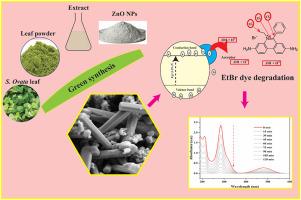海桑叶提取物生物氧化锌纳米颗粒光催化活性及生物活性的多因子评价
IF 3.8
Q2 BIOTECHNOLOGY & APPLIED MICROBIOLOGY
引用次数: 0
摘要
水体中工业废水(如纺织、造纸和皮革工业)中染料的存在是一个重要的污染源,造成生态风险,必须将其去除。本研究表明,红树海桑叶提取物是一种很有前途的生物合成氧化锌纳米颗粒(ZnO NPs)的资源,在生物医学领域和废水修复中具有潜在的应用前景。x射线衍射分析表明,这些纳米颗粒具有六方纤锌矿结构。光学测量表明在3.19 eV处存在带隙。形态学研究表明,这是一种棒状和小球形纳米颗粒的混合物。观察到的绿色合成的ZnO NPs的物理化学性质明显优于采用类似合成方法化学制备的ZnO NPs。在紫外光照射下测试了生物合成的纳米颗粒降解溴化乙啶染料的光催化效率。这种降解效率取决于染料浓度、染料pH值和催化剂浓度。根据一级动力学模型,染料浓度、染料pH和纳米催化剂浓度对溴化乙啶染料的降解率最高,分别为88.5%、98.6%和89.4%。此外,利用紫荆芥叶绿色合成的稳定纳米颗粒是有效的抗氧化剂,对金黄色葡萄球菌和大肠杆菌具有抗菌活性。这些发现强调了利用卵泡草的天然水提取物生产具有植物化学增强作用的纳米颗粒的潜力,这些纳米颗粒具有重要的光催化降解水体中的有毒染料和生物医学应用。本文章由计算机程序翻译,如有差异,请以英文原文为准。

Evaluation of biogenic zinc oxide nanoparticles from Sonneratia ovata leaf extract for multivariate factorial photocatalytic and biological activities
The presence of dyes from industrial effluents (such as textile, paper, and leather industries) in water bodies is a significant source of pollution, posing ecological risks that necessitate their removal. The present study demonstrated that the mangrove Sonneratia ovata leaf extract is a promising resource for the biosynthesis of zinc oxide nanoparticles (ZnO NPs), which have potential applications in biomedical fields and wastewater remediation. X-ray diffraction analysis revealed that these nanoparticles have a hexagonal wurtzite structure. Optical measurements indicated the presence of a band gap at 3.19 eV. Morphological studies indicated a mixture of rod-shaped and small spherical nanoparticles. The observed physicochemical properties of the green-synthesized ZnO NPs significantly surpassed the chemically prepared ZnO NPs following a similar synthesis approach. The photocatalytic efficiency of the biosynthesized nanoparticles was tested under UV light irradiation to degrade ethidium bromide dye. This degradation efficiency was shown to be dependent on dye concentration, dye pH, and catalyst concentration. The highest degradation rates of 88.5 %, 98.6 %, and 89.4 % for ethidium bromide dye, respectively, are for dye concentration, dye pH, and nanocatalyst concentration following a first-order kinetic model. Furthermore, the stabilized nanoparticles derived from the green synthesis using S. ovata leaves are potent antioxidants, exhibiting antibacterial activity against Staphylococcus aureus and Escherichia coli. These findings highlighted the potential of using natural aqueous extracts from S. ovata to produce phytochemical-enhanced nanoparticles with significant photocatalytic degradation of toxic dyes in water bodies and biomedical applications.
求助全文
通过发布文献求助,成功后即可免费获取论文全文。
去求助
来源期刊

Biocatalysis and agricultural biotechnology
Agricultural and Biological Sciences-Agronomy and Crop Science
CiteScore
7.70
自引率
2.50%
发文量
308
审稿时长
48 days
期刊介绍:
Biocatalysis and Agricultural Biotechnology is the official journal of the International Society of Biocatalysis and Agricultural Biotechnology (ISBAB). The journal publishes high quality articles especially in the science and technology of biocatalysis, bioprocesses, agricultural biotechnology, biomedical biotechnology, and, if appropriate, from other related areas of biotechnology. The journal will publish peer-reviewed basic and applied research papers, authoritative reviews, and feature articles. The scope of the journal encompasses the research, industrial, and commercial aspects of biotechnology, including the areas of: biocatalysis; bioprocesses; food and agriculture; genetic engineering; molecular biology; healthcare and pharmaceuticals; biofuels; genomics; nanotechnology; environment and biodiversity; and bioremediation.
 求助内容:
求助内容: 应助结果提醒方式:
应助结果提醒方式:


